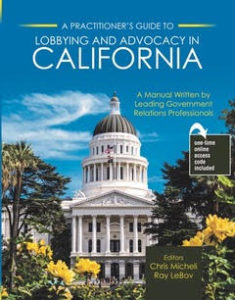As California government expands its influence over many lives and different interests in the Golden State, the art of lobbying on behalf of individuals and interests has taken on a more significant role in the state’s policy making. Now there is a roadmap for would be lobbyists and students of government to understand how lobbying works in the newly issued book, A Practitioners Guide to Lobbying and Advocacy in California.

Publisher Kendall Hunt Publishing Company calls the book a first-of-its-kind college level textbook about the lobbying profession. It was conceived by frequent Fox and Hounds contributor Chris Micheli and Ray LeBov. The uniqueness of the book is that the many chapters are written by more than 40 practicing California lobbyists and political activists representing many different kinds of interests.
Among others, chapters in the book were written by lobbyists representing transportation agencies, labor unions, businesses, the insurance industry, taxpayers and animal rights groups.
Micheli says his idea for the book came from teaching students who thirsted for “real-life stories about the legislative and lobbying processes in Sacramento.” I also find students in my Pepperdine University public policy classes are eager to hear from professionals about real world workings in how policy is created or changed. This book has the same purpose—taking the readers into a real-world application of the lobbying process.
Micheli’s objective: “I wanted to put together a textbook from leading practitioners on the ground that I knew would be an engaging read for students while also providing in-depth knowledge of why advocacy is important and how it works.”
The term lobbyist has often been cloaked with pejorative meaning since the original lobbyists hung around chambers outside the British Parliament trying to convince members– or as popular legend has it in this country, advocates trying to persuade President Ulysses S. Grant sitting in the lobby of Washington D.C.’s Willard Hotel to favor their point of view. Of course, the action of attempting to persuade governmental powers go well back in time before that, but the term came into popular usage less than 200 years ago.
Despite some negative reaction to the profession, lobbying is clearly a major piece of legislative and policy making in California and elsewhere. Any student of government or concerned citizen should understand how it works and how it affects the vital lawmaking process. The A Practitioners Guide to Lobbying and Advocacy in California is a good place to start.

